District Agricultural Farm, Taliparamba
The District Agricultural Farm, Taliparamba is one of the oldest farms in India. It is located at Karimbam village on Taliparamba to Irikkur road in Kannur district of Kerala province in India.
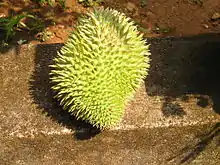
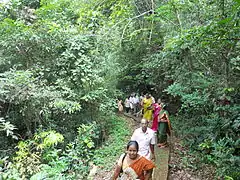
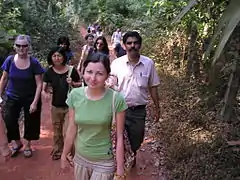

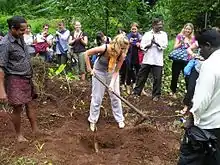
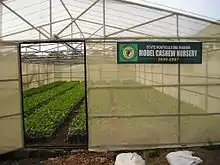
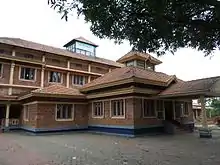

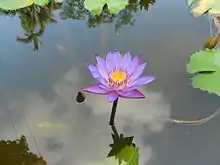

History
This farm was originally started in 1905 by Sir Charles Alfred Barber at the behest of the Madras Government, based on the recommendation of the Famine Commission of 1880 of Government of India. Although the objective was to do research on pepper, the activities of the farm were further extended to agroclimatic experiments, hybridization and production and distribution of seeds and seedlings. Covering an area of 56 hectares, the farm has a rich biodiversity with a variety of indigenous and exotic fruit trees (such as Mangosteen, Rambutan, and Durian), spices and medicinal plants. The lush greenery with its array of crops such as Coconut, Areca nut, Cashew, Mango, Sapota, Jack, Coffee, Cocoa, Nutmeg, Clove and Pepper and the adjoining paddy field attracts many nature lovers and environmentalists to the farm. Recognizing the importance of the flora and fauna of the station, Kannur District Panchayat has established a ‘Biodiversity Centre’ and an ‘Indigenous Technology Knowledge Centre’ at the farm in 2005. Thousands of students, researchers, teachers and the general public from all over the state and the neighboring states make use of the facilities of the farm to improve and update their knowledge through study visits every year.
The farm produces over 62 varieties of mango. With a collection of varieties from all over India, the farm has produced four hybrid varieties of mango namely, H 45, H 56, H 87 and H 151. The farm participates at fruit and vegetable exhibitions conducted in Kannur and the neighboring districts of Kasargod and Kozhikkode. Benganappally, Alampur Banishan, Neelam, Alphonso, Kalapady, Himayudheen, Jahangir, Chinnarasa, Panjarakalasa, Priyori and Malgoa are among the popular varieties of Mango grown and multiplied in this farm.
The farm produces and distributes to the local community rooted pepper cuttings, cashew grafts, grafts of mango, sapota, mangosteen and nutmeg, seedlings of fruit crops and spices, seedlings of arecanut, paddy seeds, vegetable seeds, banana and tuber crops (such as ginger, turmeric and yam.
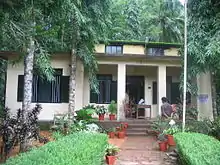
Mango Orchard
More than 60 distinct types of Mango cultivars collected from different parts of India were planted in the orchard during the fifties. Varietal characteristics are described here as observed at the farm. Almost all varieties have a wide range of adaptability under South India conditions and the performance of flowering and fruiting vary significantly based on climatic and soil factors. Also there could be considerable confusion in the nomenclature of a few varieties due to many synonyms for a single cultivar. In such cases, name of the variety along with common synonyms have been furnished.
Most of the varieties grown at the farm were collected years ago from growers and nursery men and the names signify size, shape, colour, name of a place or king and even local dialects. Hybridisation works were undertaken at the farm in the sixties and 225 hybrids were produced. Of the various hybrids assessed only a few had been found promising. Even among the hybrids of same parentage enormous variation in fruit size, shape, quality and bearing behavior were observed. A number of hybrid seedlings of each parental combination were planted in the orchard to select the desirable ones. Consequently, 4 varieties, namely H 45, H 56, H 87, H 151 were released. Details of other hybrids are mentioned elsewhere.
Alphonso
This Mango (also known as "Hapuz" or "Hafooz") is called the "King of Mangoes" by its proponents. It has a thin skin and pulp is fibreless. Extremely fragrant with a unique aroma and appealing flavor. Excellent shape, size and colour. Very good keeping quality. Its peak season is from mid-April to mid-May. The tree shows vigorous growth, however has sparse bearing habit in South India. Biennial in habit. Immature fruits are sour in taste. The most popular variety in markets abroad.
Banganpalli
Also called BANESHAN. This mango is the most famous variety from the Andhra Pradesh region of India. It has a unique sweet taste and is moderately juicy. Fruit is large in size and obliquely oval in shape. It is maize-yellow in color with shining skin and fiberless firm flesh. Good keeping quality. Biennial in habit. Its season is between mid-April and mid-May. Weighs about 700 g.
Himayudheen
First quality in terms of preferred flavor. Fully ripened fruits are green on the outside. Fibreless pulp. Fruits can be eaten in unripe form while still green. Weighs about 800 g. Peak season is from May to June.
Alampur Baneshan
One of the most delicious mango variety of the South with a unique sweet taste. fibreless pulp. The tree and the fruit resembles HIMAYUDHEEN to a larger extent. Matured fruits weighs about 750 g. Better keeping quality compared to other varieties. Harvesting season is during May–June.
Kalapady
It possesses an appealing flavor. It has a thick skin and hence keeping quality of mature fruits are better compared to others. The tree has heavy cluster bearing habits. Weighs about 250 g. Harvest season is during March–April.
H 151
First of the four hybrid varieties released from District Agricultural Farm. It is a cross between Kalapady and Neelam. To a larger extent resembles Neelam on the outside while the fibreless pulp is akin to that of Kalapady in texture. Fully ripened fruits have camphor like flavor. Heavy cluster bearing type. It normally flowers quite early in the season, however takes time to get matured. It weighs about 250 g. The tree is somewhat dwarf with late bearing habits. Harvesting season is during June–July. Sometimes flowers appear twice in a year, whence harvesting can be done in March also.
H 87
Second of the four hybrid varieties released from District Agricultural Farm. It is a cross between Kalapady and Alampur Baneshan. Fibreless and juicy. The best time for the fruit is during April–May. Weighs about 300 g. To a larger extent the size and growing habits of the tree resembles Kalapady. The tree has regular bearing habit.
H 45
A cross between Bennett Alphonso and Himayudheen, this is third hybrid released from District Agricultural Farm. Fruit resembles Bennet Alphonso in shape. Fully ripened fruits are green on the outside with the yellowish pulp having sweet aroma and a unique flavor. It weighs about 500 g. Cluster bearing with vigorous growth habit. Harvesting season is during May–June.
H 56
The fourth hybrid variety released from District Agricultural Farm. It is a cross between Bennett Alphonso and Himayudheen. The fruit, weighing about 400 g, has thick pulp and has an Apple like shape. Slightly sour when not fully ripened. Harvesting season is during May–June. The tree has heavy cluster bearing habit.
Neelam
Grows in a variety of climatic conditions. This variety is found to be cultivated largely in South India, especially Karnataka and Andhra Pradesh. Regular and heavy cluster bearing habit. Late bearing with harvesting season being June to August. Good keeping quality. Fibreless fruits are sweet to taste. Average fruit weight is 150 g. Pulp percentage is 59.
Jahangir
Fibreless fruit can be eaten in unripe form while still green as they lack acidity. Big in size, the fruit weighs about 600 g. The tree has regular, heavy cluster bearing habit, however growth is not vigorous.
Panchadara Kalasa
Sucking type characterized by juicy and soft flesh with fibres. attractive shape. Produce fruits in bunches. The fruit weighs about 350 g. Harvesting season is during May–June.
Suvarnarekha
Attractive golden colour with a red blush on the cheeks, when fully ripe. Fibrous juicy fruits are slightly sour. Fruit is medium in size and ovate oblong in shape. Fruit quality is medium and keeping quality is good. Harvesting season is during May–June.
Bangalora
Also called Selam, Kilichundan, Thothapuri, Kilimooku. Second in terms of preferred flavor. It can be identified by its unique beak at the bottom. Pulp is fibreless, thick and juicy. Known as the mango of the common man. Big and affordable, it has no unique flavor of its own. Stone inside is virtually flat. Medium sweet in taste. Season is from May to June. Polyembryonic. The tree has regular and heavy cluster bearing habits. Very good keeping quality.
Malgoa
Widely cultivated in Andhra Pradesh. Large and round fruits with a distinct taste of its own. Good keeping quality. Medium sweet in taste. Season is during May–June. Weighs about 400 g.
Ammini
Only immature fruits can be consumed. The fruits lack palatability when ripe. The big fruits are of ornamental nature and serve as a sort of curiosity. However immature fruits can be used for pickle. The fruit weighs around 1 kilogram. Harvesting season is during May–July
Amrapali
Evolved at IARI, Newdelhi in 1978. It is a cross between Dashehari and Neelam.it is a dwarf vigorous type with regular, prolific and late bearing habits. It yields on average 16 tonnes per hectare. Suitable for high density orcharding. Relatively small fruit size. Regular and prolific bearing. High pulp percentage. The flesh is deep orange-red.
Mundappa
The tree has regular bearing habit. Fruit weighs more than 300 g. Harvesting season is May–June
Chotta Jahangir
It possesses all the characteristics of Jahangir, except for the size of the fruit which is slightly smaller.
Creeping
Fruit is medium sweet in taste. Thick skinned. Weighs around 150 g. Season is during May–June
Chittur
Fruit is medium sweet in taste. Harvesting season is May–June
Kudadad
Fruit weighs around 500 g. Thick skinned. Slightly fibrous. Season is during May–June
Rootjack
Size as big as a jack fruit, hence the name. Weighs about 2-3 kilograms. Mainly used for preparation of pickling. Harvesting season is during May–June
Puttu
Fruits are slightly sour even when fully ripe. Weighs around 400 g. Season is May–June
Maharajpasand
Big sized fruit weighing about 1 kilogram. Used for pickles. Harvesting season is May–June
Olour
Polyembryonic variety
Phirangi Ladua
Ripened fruits are sweet. Fruits weigh around 400 g. Harvesting season is May–June
Padiri
A promising mango variety for processing
Kadri
Greenish in colour even when ripe
Manoranjitham
A unique mango variety called Manoranjitam in Chittoor of Andhra Pradesh is useful in fighting night blindness as it is high in vitamin A. But, not many beyond its growing region are aware of its useful properties. Manoranjitam is just one of the hundreds of fruits that are underutilised despite their neutraceutical (functional) properties.
Rumani
A variety of south India. Slightly sour even when fully ripe. Weighs around 350 g. Season is during May–June.
Vellakolamban
The tree normally ripens early in the season. Fruit is fibrous. Tree has regular bearing habit. Weighs around 200 g. Season is during March–May.
Kurukkan
Polyembryonic variety
Mylepelian
Polyembryonic variety
Mallika
It is a cross between Neelam and Dashehari. Released by IARI, Newdelhi in 1971. Fruits are medium sizes cadmium colored with good quality. The tree is semi-vigorous, medium to heavy cropper and has a strong tendency to bear regularly. The fruit has an attractive appearance and the average fruit weight is 300 g. Pulp percentage is 74. Pulp is fibreless and firm and the stone is very thin. Good keeping quality.
Chandrakkaran
Fruits are small in size. Sweet and Juicy. can be used for pickling. The phenomenon of polyembryony (formation of more than one embryo in the seed) is known to occur in this variety. Mango season is during March–April
Karimbam Biodiversity Centre
The Biodiversity Centre was inaugurated at the farm in 2005 with the objective of protection of the rich biodiversity of the area. An arboretum for scientific study of the region's flora was set up in the year 2006. The centre also has a museum of rare medicinal plants.
Indigenous Technology Knowledge Centre
The Centre, first of its kind to be developed in the State, is expected to evolve into an informal university to promote studies and researches on indigenous knowledge and agricultural practices. An agricultural information centre has been set up at the Centre.
References
Sources
- http://www.hindu.com/2005/08/23/stories/2005082305680300.htm
- http://www.thehindu.com/2005/07/27/stories/2005072708360300.htm
- http://www.hindu.com/2006/04/04/stories/2006040402350200.htm
- http://searches2.rootsweb.com/th/read/INDIA/2008-04/1208368688
- http://www.thehindu.com/todays-paper/tp-national/tp-kerala/listing-plant-diversity-of-the-karimbam-farm/article3142215.ece
- http://www.thehindu.com/todays-paper/tp-national/tp-kerala/heritage-building-in-ruins/article1855131.ece
- http://www.thehindu.com/todays-paper/tp-national/tp-kerala/article156977.ece
- http://www.jstor.org/pss/4113533
- http://www.deccanchronicle.com/lifestyle/viral-and-trending/120816/karimbam-farm-born-out-of-famine.html
External links
| Wikimedia Commons has media related to District Agricultural Farm, Taliparamba. |